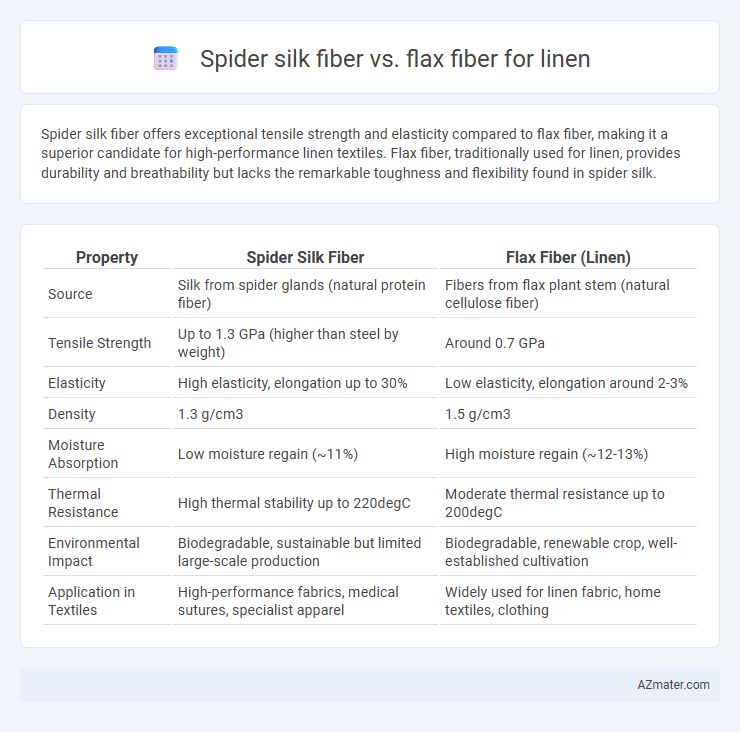Spider silk fiber offers exceptional tensile strength and elasticity compared to flax fiber, making it a superior candidate for high-performance linen textiles. Flax fiber, traditionally used for linen, provides durability and breathability but lacks the remarkable toughness and flexibility found in spider silk.
Table of Comparison
| Property | Spider Silk Fiber | Flax Fiber (Linen) |
|---|---|---|
| Source | Silk from spider glands (natural protein fiber) | Fibers from flax plant stem (natural cellulose fiber) |
| Tensile Strength | Up to 1.3 GPa (higher than steel by weight) | Around 0.7 GPa |
| Elasticity | High elasticity, elongation up to 30% | Low elasticity, elongation around 2-3% |
| Density | 1.3 g/cm3 | 1.5 g/cm3 |
| Moisture Absorption | Low moisture regain (~11%) | High moisture regain (~12-13%) |
| Thermal Resistance | High thermal stability up to 220degC | Moderate thermal resistance up to 200degC |
| Environmental Impact | Biodegradable, sustainable but limited large-scale production | Biodegradable, renewable crop, well-established cultivation |
| Application in Textiles | High-performance fabrics, medical sutures, specialist apparel | Widely used for linen fabric, home textiles, clothing |
Introduction to Spider Silk and Flax Fibers
Spider silk fiber, known for its exceptional tensile strength and elasticity, is a natural protein fiber produced by spiders, offering remarkable durability and lightweight properties. Flax fiber, derived from the flax plant, is the primary material for traditional linen textiles, prized for its breathability, moisture-wicking ability, and smooth texture. Both fibers represent sustainable alternatives in textile production, with spider silk excelling in strength and flexibility while flax provides natural comfort and biodegradability.
Origin and Extraction Processes
Spider silk fiber originates from the orb-weaving spiders, extracted through a delicate process of harvesting silk threads directly from the spider's spinnerets by hand or with specialized devices, ensuring minimal harm to the spider. Flax fiber, derived from the flax plant (Linum usitatissimum), undergoes retting, breaking, and scutching to separate the long bast fibers used in linen production. The extraction of spider silk is far more labor-intensive and yields lower quantities compared to the agricultural scale and mechanical processing of flax fibers.
Physical Properties Comparison
Spider silk fiber exhibits exceptional tensile strength, elasticity, and toughness, surpassing flax fiber in mechanical performance for linen applications. Flax fiber, derived from the flax plant, offers higher stiffness and moisture-wicking properties, contributing to linen's breathability and durability. The unique protein structure of spider silk provides superior resilience and flexibility, making it ideal for advanced textiles requiring a combination of strength and softness.
Strength and Durability Analysis
Spider silk fiber exhibits exceptional tensile strength, surpassing flax fiber by a significant margin, making it one of the strongest natural materials available for linen production. Its remarkable durability stems from a unique protein structure that provides superior elasticity and resistance to wear compared to the cellulose-based flax fiber. While flax fiber offers good strength and breathability, spider silk's combination of toughness and flexibility ensures longer-lasting linen fabrics under mechanical stress.
Flexibility and Texture Differences
Spider silk fiber exhibits exceptional flexibility due to its high tensile strength and elasticity, making it softer and more pliable compared to flax fiber. Flax fiber, the primary material for linen, has a coarse texture that can feel rough and stiff, whereas spider silk creates a smoother, silkier fabric with a finer hand feel. These differences highlight spider silk's potential to enhance linen textiles by providing superior softness and flexibility.
Moisture Management Capabilities
Spider silk fiber exhibits superior moisture management capabilities compared to flax fiber, absorbing and releasing moisture efficiently to maintain skin dryness and comfort. Flax fiber, commonly used in linen, offers good breathability but tends to retain moisture longer, potentially resulting in a damp feel during prolonged wear. Advanced spider silk-based textiles enhance temperature regulation by rapidly wicking sweat away from the body, outperforming traditional flax linens in moisture control.
Biodegradability and Environmental Impact
Spider silk fiber exhibits exceptional biodegradability due to its natural protein-based structure, breaking down efficiently without releasing harmful residues into the environment. Flax fiber, the primary source of linen, is also biodegradable but requires significant water and pesticide inputs during cultivation, impacting its overall environmental footprint. Compared to flax, spider silk production is emerging as a more sustainable alternative with minimal chemical use and reduced land demands, positioning it as a promising eco-friendly fiber for textile applications.
Applications in Textile Industry
Spider silk fiber exhibits exceptional tensile strength, elasticity, and biocompatibility, making it ideal for high-performance textiles and medical applications such as wound dressings and biodegradable sutures. Flax fiber, primarily used in linen production, offers durability, moisture-wicking properties, and natural luster, widely utilized in fashion garments, upholstery, and home textiles. Both fibers serve distinct niches within the textile industry, with spider silk catering to innovative, technical fabrics and flax fiber dominating sustainable, breathable linen textiles.
Cost and Availability Considerations
Spider silk fiber is significantly more expensive and less available than flax fiber, primarily due to challenges in large-scale production and harvesting. Flax fiber, used commonly in linen textiles, benefits from established agricultural practices worldwide, ensuring consistent supply and lower costs. Cost-effectiveness and widespread availability make flax fiber the preferred choice for linen fabric manufacturing.
Future Prospects: Innovations and Research
Spider silk fiber offers unparalleled tensile strength and elasticity compared to flax fiber, promising revolutionary advancements in linen textiles. Ongoing research explores bioengineered spider silk production to scale sustainable and biodegradable linen alternatives with enhanced durability and moisture management. Innovations in blending spider silk with flax fiber could create hybrid fabrics that combine natural texture with superior performance, positioning the industry for cutting-edge eco-friendly linen solutions.

Infographic: Spider silk fiber vs Flax fiber for Linen
 azmater.com
azmater.com